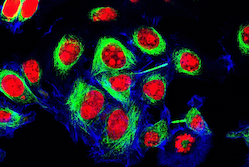New generation of scientists pushes the boundaries of imaging technology
Let’s take light microscopy-based imaging as an example. According to Kees Weijer, Professor of Division of Cell and Developmental Biology at the University of Dundee and coordinator of PHOQUS, the latter is “rapidly developing to be one of the key techniques to observe the dynamics of living systems”. Yet the potential of this technology is still hindered by its technical limitations: in their quest for ever higher resolution, scientists have been faced with increasing level of photo-damage caused by the observation techniques they used. And whilst new methods to overcome these problems are being devised, this development process would usually take place in physics laboratories whereas its applications are in life science laboratories. “One of the aims of this project was to design and build novel instruments in a life science environment. These are tailored to specific experimental requirements, as part of a close collaboration between life scientists and photonics researchers. This involved the development of a common understanding of biological and physical principles and problems, as there are only few people mastering these two aspects,” Prof. Weijer says. PHOQUS successfully trained 13 Early Stage Researchers (ESRs) with backgrounds in physics, photonics, molecular biology, biotechnology and biomedical engineering. It also kick-started specific research projects to address complex processes in living organisms. The list of PHOQUS achievements is long, to say the least. For one, the project successfully implemented high resolution STimulated Emission Depletion (STED) microscopy that allows for the observation of fluorescent structures beyond the diffraction limit. This microscopy was shown to work well in fixed samples, and Prof. Weijer points out that experiments are ongoing to test its suitability for use in live samples. Additionally, the project further developed fast light-sheet microscopy, which allows for high temporal and spatial resolution in long term observation of cells and tissues in living embryos up to several days, whilst reducing photodamage compared to conventional techniques. “This has given novel insights in the cellular mechanism that control gastrulation in chick embryos, a model for human development,” Prof Weijer explains. Other notable outcomes include progress in the integration of optical tweezers in microscopes; novel methods to image through single and multimode fibres; novel probes to detect biologically important molecules in angiogenesis and innervation of tumours; methods to measure the mechanical parameters of gut derived wildtype and cancer predisposed organoids; non-invasive spectroscopic techniques and data processing to measure blood flow and oxygenation; and a novel semiconductor-based low cost infrared pulsed laser. Although the project is now completed, Prof. Weijer says that established collaborations between life scientists and physicists in Dundee, and academic partners from other organisations, will be pursued. “We are attempting to follow-up with further training programmes and project specific grant applications,” he explains. In the long run – besides advances in state-of-the art and publications in high-impact journals – one of the most valuable contributions of PHOQUS will most likely prove to be the new generation of scientists it helped to thrive. Out of the 13 researchers, almost all have already successfully submitted a thesis or passed a PhD viva, and are on the brink of a promising career.







